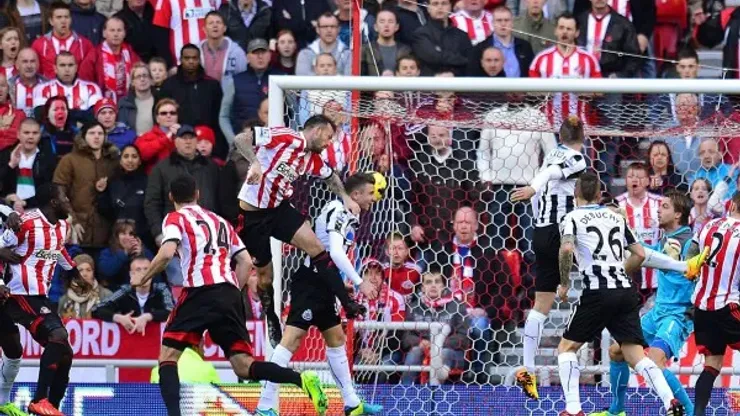The rivalry between Tyne and Wear stretches far beyond feisty soccer matches. They are merely a modern day manifestation of a historical hatred. The discontent in relations between Geordies and Mackems is bitter and fuelled by almost 400 years of conflict and resentment.
The many years of hostility between the two cities is principally dated back to the English Civil War. With Sunderland discontent at the coal trading rights afforded to Newcastle, the Wearsiders aligned with the rebel Parliamentarians. Newcastle remained loyal to Charles I and the rivalry was born, culminating in the Battle of Boldon Hill, where the Sunderland based anti-Monarchists won, establishing a base for the rebels in the North.
The animosity was not re-embodied in football until the late 19th century. The sides first met in 1887, with Sunderland emerging 2-0 victors in an FA Cup fixture. Other notable moments in the history of the derby include Sunderland’s 9-1 victory at St James’ Park in 1908, along with Newcastle’s 6-1 triumphs at home to Sunderland in 1920 and 1955. The most crucial meeting of the two sides arguably came in the 1990 playoff final, where following a goalless first leg, Sunderland beat their fierce rivals 2-0 away.
More recently, the Geordies embarrassed the Mackems 5-1 in October 2010 when a Kevin Nolan hat-trick sparked a horror Halloween for Sunderland fans. However, since that disaster on Tyneside, Sunderland have largely had the best of the fixture. Unbeaten since August 2011, the Black Cats have recorded a staggering four victories in a row, including two 3-0 successes on enemy territory. Despite being consistently poor for several seasons, the current crop of Sunderland players have repeatedly performed in what has often been the most important game of the season.
Reasons why this derby is so ferociously competitive are varied, yet a few salient facts paint a picture of the divide. The North East is fairly alienated as a footballing region. Middlesbrough and Leeds are the only big clubs within reasonable proximity and even they are situated a substantial distance from Newcastle and Sunderland. As a consequence, the North East support is principally dissected in two, with fans staunchly supporting the red and whites or black and whites.
Whereas other areas of the country also boast fierce rivalries, the geographical nature of many other clubs result in a more diverse range of teams supported. For example, Manchester United and Liverpool is a rivalry predominantly born out of success. Despite the intense rivalry, Manchester City and Everton remain in close geographical proximity, leading to a variance in team allegiance throughout Manchester and Liverpool. For all a fixture such as Manchester United against Liverpool is intense, the support in the surrounding area is split in at least four directions, as opposed to the North East polarisation between two rival fan groups. London rivalries are subject to similar geographical factors — the ferocity of rivalries is sometimes diluted as a product of the sheer number of clubs in the region, which in-turn means that teams often play more than one derby match a season. For the Mackems and Geordies, it’s all about one fixture.
Neither Sunderland nor Newcastle have achieved much in recent times, a factor that has increased the significance of the derby games. North East fans acknowledge that their sides won’t be regularly competing at the top end of the Premier League, hence the derby has been built up as the potential fulcrum of a successful season.
In the grand scheme of things, Sunderland’s last season was extremely poor. The side lost an appalling 22 games, yet the campaign was heralded as a great success, why? Because they beat Newcastle twice, avoided relegation and went to Wembley. With big games rare for both clubs, the importance of the Tyne-Wear derby cannot be underestimated — it’s a fixture where heroes are made. From Shola ‘The Mackem Slayer’ to ‘Richardson’s Rocket’, many a player has written themselves into folklore in this huge encounter.
The last derby took place shortly before Christmas time, with Adam Johnson notching a 90th minute winner, following an excellent counter-attacking goal. At present, both sides come into the fixture in disastrous form. Newcastle’s season has well and truly drifted into the realms of obscurity, whilst Sunderland find themselves once again scrapping desperately for survival.
The outcome on Sunday is highly unpredictable, but one thing’s for sure, passion levels will run extremely high as a historical hatred is intensified for 90 minutes.
200+ Channels With Sports & News
- Starting price: $33/mo. for fubo Latino Package
- Watch Premier League, Women’s World Cup, Euro 2024 & Gold Cup
The New Home of MLS
- Price: $14.99/mo. for MLS Season Pass
- Watch every MLS game including playoffs & Leagues Cup
Many Sports & ESPN Originals
- Price: $10.99/mo. (or get ESPN+, Hulu & Disney+ for $14.99/mo.)
- Features Bundesliga, LaLiga, Championship, & FA Cup
2,000+ soccer games per year
- Price: $5.99/mo
- Features Champions League, Serie A, Europa League & Brasileirāo
175 Premier League Games & PL TV
- Starting price: $5.99/mo. for Peacock Premium
- Watch 175 exclusive EPL games per season






